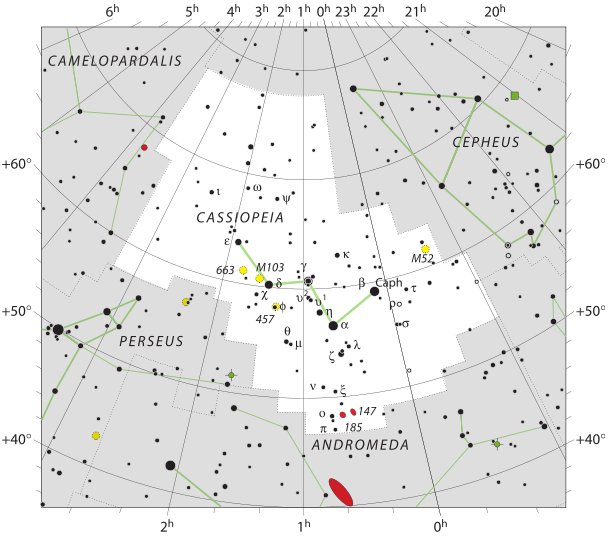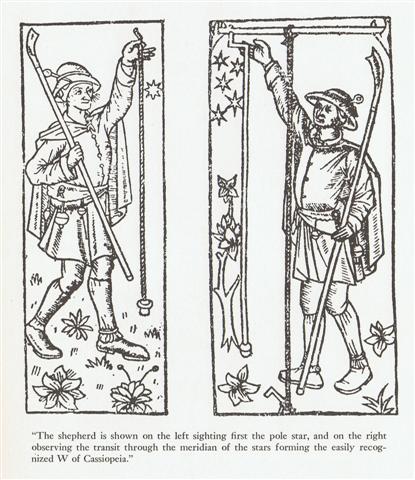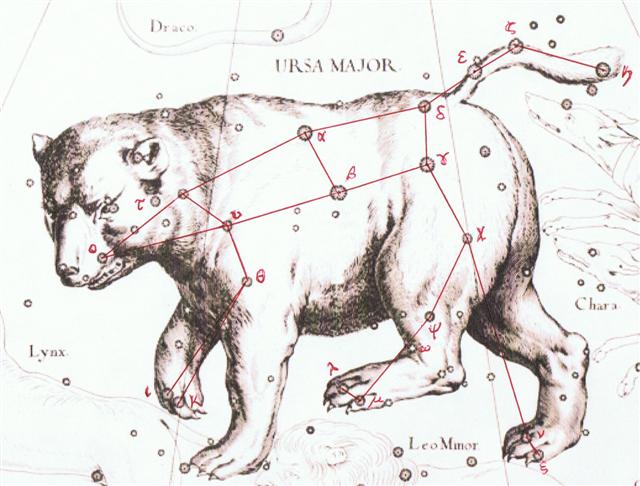220. But if the fixed stars defined
fixed solstices and equinoxes, then the
precession would make it necessary to
gradually change the time of observation. In
order to make April 1 (456 = 91 + 365) correspond to the
first day after day 355
(December 21) it would be necessary to
change
the time of observation of the relevant stars close
to the Full Moon to a night correspondingly earlier.
101 / 365¼ * 24h = 6h 38m
11.6s and instead of observing the midnight
culmination of a star - which was more
precise than looking at the Full Moon and
also possible to do in all the nights of the
month - the proper time for looking at its culmination
had to be earlier
than in ancient times.
Allen has listed his culminations at 21h,
which corresponds to 3h / 24h * 360º = 45º
before midnight, and April 1
(91) - 3h / 24h * 365¼ = 45 (February 14,
2-14 ), which agrees well with the position
of the Whip star (γ Cassiopeia).

... Cassiopeia is read in the
night when
in a low position as Celestial W [as
in Woman] when
below the pole in contrast to the
Celestial M [as in Man] when above it ...
... February 14 is still remembered as All
Hearts' Day (St Valentine's day) and in
addition to our usual associations related
to this date we can now add the idea of a
beginning for all the cycles - as we know
from the corresponding Hathor 'heart':
... In the inscriptions of Dendera,
published by Dümichen, the goddess Hathor
is called 'lady of every joy'. For once,
Dümichen adds: Literally ... 'the lady of
every heart circuit'. This is not to say
that the Egyptians had discovered the
circulation of the blood. But the
determinative sign for 'heart' often figures
as the plumb bob at the end of a plumb line
coming from a well-known astronomical or
surveying device, the merkhet.

Evidently, 'heart' is something very
specific, as it were the 'center of gravity'
... See Aeg.Wb. 2, pp. 55f. for sign of the
heart (ib) as expressing generally
'the middle, the center'.

And this may lead in quite another
direction. The Arabs preserved a name for
Canopus - besides calling the star Kalb
at-tai-man ('heart of the south') ...
Suhail el-wezn, 'Canopus Ponderosus',
the heavy-weighing Canopus, a name promptly
declared meaningless by the experts, but
which could well have belonged to an archaic
system in which Canopus was the weight at
the end of the plumb line, as befitted its
important position as a heavy star at the
South Pole of the 'waters below'.
Here is a chain of inferences which might or
might not be valid, but it is allowable to
test it, and no inference at all would come
from the 'lady of every joy'. The line seems
to state that Hathor (= Hat
Hor, 'House of Horus') 'rules' the
revolution of a specific celestial body -
whether or not Canopus is alluded to - or,
if we can trust the translation 'every', the
revolution of all celestial bodies. As
concerns the identity of the ruling lady,
the greater possibility speaks for Sirius,
but Venus cannot be excluded; in Mexico,
too, Venus is called 'heart of the earth'
...
And then, considering the fact that July
(31) and August (31) had been added in Roman
times it seems reasonable to assume 107 (=
45 + 31 + 31) to be the key number for
keeping track of the Sun. Furthermore, 16 *
29½ - 107 = 365.
 |
 |
 |
 |
 |
 |
|
*Ca14-12 |
→ 14 * 13 = 182 |
→ 4.14 |
(378 → Saturn) |
→ 14 * 16 = 224 |
*Ca14-17 |
|
te kihikihi |
o te henua -
kua haga hia |
kua pua |
te vero |
te henua |
kiore - te
henua |
|
CLOSE TO THE FULL MOON (and
nakshatra dates): |
|
ξ
Phoenicis (9.0),
ρ
Tucanae (9.1),
DENEB KAITOS (Tail of the Sea
Beast) =
β
Ceti,
η
Phoenicis (9.4),
AL NITHĀM (String of Pearls) =
φ¹
Ceti
(9.6) |
ACHIRD (Woman with Luminous
Rays) =
η
Cassiopeiae
(10.7) |
Legs-15 (Wolf)
ν
Andromedae (11.0),
φ²
Ceti (11.1),
ρ
Phoenicis (11.2),
η
Andromedae
(11.4) |
CIH
(Whip) =
γ
Cassiopeiae,
λ
Tucanae (12.4),
φ³
Ceti (12.6),
μ
Andromedae (12.8) |
φ4 Ceti (13.2) |
no star listed (14) |
|
... At the beginning of 44 B.C.
- when Ceasar was still alive -
the Senate decided to raise
statues of him in all the
temples and to sacrifice to him
on his birthday in the month
Quintilis, which in honour
of him was renamed July. He was
raised to the status of a god
(among the other gods of the
state) under the name Jupiter
Julius. Marcus Antonius, who
this year was consul together
with Ceasar, became high priest
and responsible for the
ceremonies. In the middle of
February, at the time of the old
feast of Lupercalia [cfr
Lupus = Wolf], he
ran around naked and whipped the Roman
ladies with thongs made from
goat-skin [februa], in
order to promote their fertility
... |
|
March 30 |
31 (455) |
April 1 (91) |
2 |
3 |
4 |
|
'March 3 (427) |
(2 * 214) |
5 (8 * 8 = 91 - 27) |
6 |
7 (2 * 31 + 4) |
8 (6 * 72) |
|
366 |
367 |
365 + 3 |
369 |
740 / 2 |
371 |
|
INVISIBLY CLOSE TO THE SUN
(helical dates): |
|
Sept 29 |
30 (273 = 3 * 91) |
Oct 1 |
2 |
3 |
4 |
|
ι Crucis (192.2), β Muscae
(192.5),
MIMOSA = β Crucis
(192.9) |
no star listed (193) |
κ Crucis (194.4), ψ Virginis
(194.5), μ Crucis, λ Crucis
(194.6),
ALIOTH (Fat Tail) = ε Ursae
Majoris,
ι Oct. (194.8) |
MINELAUVA = δ Virginis
(195.1),
COR CAROLI = α Canum Ven.
(195.3) |
δ Muscae (196.5),
VINDEMIATRIX (Grape Gatherer) =
ε Virginis
(196.8) |
13h (197.8)
ξ¹ Centauri (197.1), ξ² Centauri
(197.9) |
 |
 |
 |
 |
 |
 |
|
*Ca14-18 |
→ 14 * 19 = 266 |
(383) |
(392 - 8) |
*Ca14-22 |
(392 - 6) |
|
te honu paka |
te henua |
honu kau |
te mata |
te honu |
kua heheu |
|
CLOSE TO THE FULL MOON (and
nakshatra dates): |
|
1h (15.2)
β Phoenicis (15.1), υ
Phoenicis, ι Tucanae (15.6),
η Ceti, ζ Phoenicis (15.7) |
Al Batn Al Hūt-26 (Belly of
the Fish) /
Revati-28 (Prosperous) / 1-iku
(Field Measure)
MIRACH (Girdle) = β
Andromedae, KEUN MAN MUN
(Camp's South Gate) = φ
Andromedae
(16.0),
ANUNITUM
= τ Piscium
(16.5),
REVATI (Abundant) = ζ
Piscium
(16.9)
REGULUS (α Leonis)
|
ν Phoenicis (17.4), κ
Tucanae (17.6) |
no star listed (18) |
ADHIL
(Garment's Train) = ξ
Andromedae
(19.3), θ Ceti (19.7) |
KSORA
(Knee) = δ Cassiopeiae
(20.1), ω Andromedae (20.6),
γ Phoenicis (20.8) |
|
April 5 (460) |
(8 + 88) |
7 |
8 |
(464 = 99 + 365) |
10 (100) |
|
'March 9 |
10 (366 + 69) |
11 (436) |
12 (71) |
13 |
14 (3-14) |
|
364 + 8 |
435 - 62 |
374 |
375 |
464 - 88 |
377 |
|
INVISIBLY CLOSE TO THE SUN
(helical dates): |
|
October 5 |
6 |
7 |
8 |
9 |
10 (283) |
|
APAMI-ATSA (Child of Waters)
= θ Virginis,
ψ Hydrae (198.5),
DIADEM = α Com. Ber.
(198.9) |
AL DAFĪRAH (Tuft) = β Com.
Ber.
(199.4) |
σ Virginis (200.4) |
γ Hydrae (201.0), ι Centauri
(201.4) |
Al Simāk-12 (Lofty) /
Chitra-14 (Bright One) /
Horn-1 (Crocodile) /
Sa-Sha-Shirū-20 (Virgin's
Girdle) /
ANA-ROTO
(Middle pillar)
MIZAR (Girdle) = ζ Ursae
Majoris
(202.4),
SPICA
= α Virginis,
ALCOR = 80 Ursae Majoris
(202.7)
SADALMELIK (α Aquarii)
|
71 VIRGINIS
(203.6) |
|
... Proclus informs us that
the fox star nibbles
continuously at the thong of
the yoke which holds
together heaven and earth;
German folklore adds that
when the fox succeeds, the
world will come to its end.
This fox star is no other
than Alcor, the small
star g near zeta Ursae
Majoris (in India
Arundati, the common
wife of the Seven Rishis,
alpha-eta Ursae
... |
The midline (the
Girdle) of Andromeda, Mirach, was
always where Regulus (the Little
King) culminated and the other
Girdle, Mizar (ζ
Ursae Majoris), was always
where the other king, Sadalmelik
(the Lucky King) culminated. At
least as long as the Fox had not
bitten through the thong.

|








